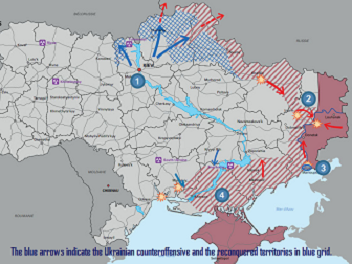«There are good reasons to question the Russian armed forces’ ability to seize and hold the portions of Donetsk and Luhansk oblasts that it does not currently control», reports the Institute for the Study of War with HQ in Washington, DC. 
Washington DC, Apr. 9.– We assess that the Russian military will struggle to amass a large and combat-capable force of mechanized units to operate in Donbas within the next few months. Russia will likely continue to throw badly damaged and partially reconstituted units piecemeal into offensive operations that make limited gains at great cost. The Russians likely will make gains nevertheless and may either trap or wear down Ukrainian forces enough to secure much of Donetsk and Luhansk Oblasts, but it is at least equally likely that these Russian offensives will culminate before reaching their objectives, as similar Russian operations have done.
The US Department of Defense (DoD) reported on April 8 that the Russian armed forces have lost 15-20 percent of the “combat power” they had arrayed against Ukraine before the invasion. This statement is somewhat (unintentionally) misleading because it uses the phrase “combat power” loosely. The US DoD statements about Russian “combat power” appear to refer to the percentage of troops mobilized for the invasion that is still in principle available for fighting—that is, that are still alive, not badly injured, and with their units. But “combat power” means much more than that.
US Army doctrine defines combat power as “the total means of destructive, constructive, and information capabilities that a military unit or formation can apply at a given time.” It identifies eight elements of combat power: “leadership, information, command and control, movement and maneuver, intelligence, fires, sustainment, and protection.” This doctrinal definition obviously encompasses much more than the total number of troops physically present with units and is one of the keys to understanding why Russian forces have performed so poorly in this war despite their large numerical advantage. It is also the key to understanding the evolving next phase of the war.
US DoD statements that Russia retains 80-85 percent of its original mobilized combat power unintentionally exaggerate the Russian military’s current capabilities to fight. Such statements taken in isolation are inherently ambiguous, for one thing. They could mean that 80-85 percent of the Russian units originally mobilized to fight in Ukraine remain intact and ready for action while 15-20 percent have been destroyed. Were that the case, Russia would have tremendous remaining combat power to hurl against Ukraine. Or, they could mean that all the Russian units mobilized to invade Ukraine have each suffered 15-20 percent casualties, which would point to a greatly decreased Russian offensive capacity, as such casualty levels severely degrade the effectiveness of most military units. The reality, as DoD briefers and other evidence make clear, is more complicated, and paints a grim picture for Russian commanders contemplating renewing major offensive operations.
(...)
[ Full text ]
Comments powered by CComment